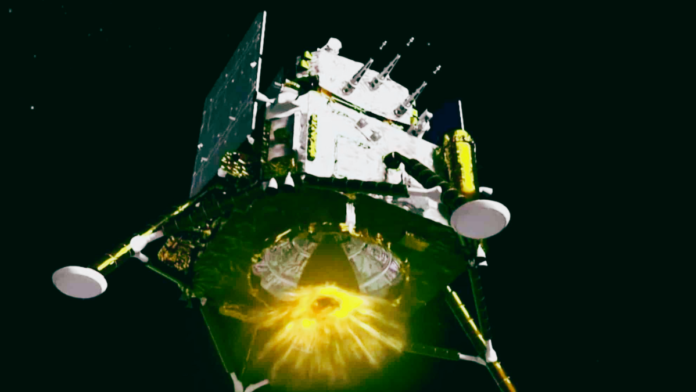China’s Chang’e-6 lunar module has made a triumphant return to Earth, bringing back the first-ever samples from the moon’s far side. The Chang’e-6 Lunar Mission not only marks a significant milestone in China’s ambitious space exploration program but also holds global significance, shaping the future of lunar exploration and scientific discovery.
Here’s what HTC News knows:

Touchdown in Inner Mongolia
The Chang’e-6 re-entry module landed safely in northern Inner Mongolia after 2 p.m. local time. A live broadcast showed the module descending via parachute, landing to cheers and applause from the control room. Within minutes, a search team found the module and began preliminary checks beside a proudly displayed Chinese flag.
A Giant Leap for China’s Space Dreams
The Chang’e-6 Lunar Mission is pivotal in China’s quest to become a leading space power, a vision championed by Chinese leader Xi Jinping. With objectives to send astronauts to the moon by 2030 and establish a research base at the lunar south pole, China is in direct competition with other nations, including the United States, which also has lunar ambitions.
Moon Dust and Rocks
Chang’e-6 is anticipated to have returned with a substantial haul of up to 2 kilograms of lunar material. These samples, unique to the lunar far side, particularly the South Pole-Aitken basin where they were collected, hold a treasure trove of information about the moon’s and Earth’s early history. They are now set to be meticulously analyzed in China and shared with international scientists, promising exciting new insights.
The Complexity of Chang’e-6 Lunar Mission
The Chang’e-6 Lunar Mission was a testament to China’s technological prowess. It involved a series of sophisticated maneuvers: a drill and robotic arm meticulously collected the samples, which were then lifted from the lunar surface by an ascender. These were subsequently transferred to a re-entry vehicle in lunar orbit, which successfully returned to Earth. The sheer technical complexity of this mission has been a source of fascination for the Chinese public since its launch on May 3.
Scientific Gold Mine
The moon’s far side, first imaged by the Soviet Union’s Luna 3 in 1959, presents a stark contrast to the near side. Its heavily cratered landscape holds ancient secrets that could revolutionize our understanding of the solar system. Scientists worldwide, including planetary geoscientists like James Head from Brown University, are eagerly anticipating the potential discoveries from these samples, sparking a sense of intrigue and excitement.
(more HTC News General Topics)
Future Lunar Exploration
The Chang’e-6 mission is not just about answering fundamental scientific questions. It also serves as a stepping stone for future lunar resource utilization. Researchers are actively exploring the potential of lunar soil for 3D printing construction materials and extracting valuable gasses like Helium-3, oxygen, and hydrogen. These resources could potentially support sustained lunar exploration, hinting at a future where the moon becomes a crucial hub for space activities.
Global Race to the Moon
Chang’e-6 is part of a broader series of Chinese lunar missions to establish a human presence on the moon. This comes as the US plans to launch its crewed Artemis mission by 2026. NASA chief Bill Nelson has highlighted the competitive aspect of lunar exploration, emphasizing the strategic importance of the lunar south pole, which is believed to contain water and ice and is crucial for future missions.
International Collaboration and Competition
Amidst the competitive landscape of lunar exploration, China’s space endeavors stand out for their commitment to benefiting all humanity. China actively seeks international partners for its planned lunar research station, fostering a spirit of collaboration and shared progress. This approach, along with the efforts of other countries and private companies, instills hope for a future of collective space exploration.
Looking Ahead: Chang’e-7 and Beyond
The Chang’e-6 Lunar Mission will continue with the Chang’e-7 Mission. It will target the lunar south pole in 2026, followed by Chang’e-8 in 2028. These missions will focus on testing lunar resource utilization and laying the groundwork for an international research station.
The return of Chang’e-6 marks a historic achievement for China. It sets the stage for an exciting new era of lunar investigation and scientific discovery.
read more: Unveiling the Stars: 2024 Investment News Awards Winners























